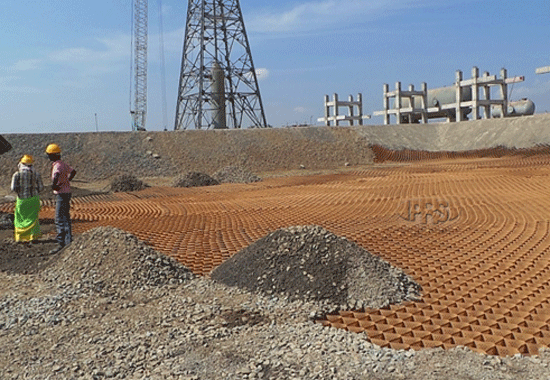Reservoir Geomembrane Protection Against Damage
Neoloy®Tough-Cells provided the reservoir geomembrane protection required on a soft silty sand with a high water table, resulting in ground stabilization.


The design of a new compression station for the Gujarat State Petroleum Corporation (GSPC) included a power station and four cooling ponds. The facility located in Mallavaram, Andhra Pradesh is part of GSPCs gas pipeline transmission network expansion.
However the native soil of the site was comprised of non-homogeneous soft silty sand with a high water table. The subgrade had non-uniform bearing capacity. Hydrostatic pressure from the water and the self-weight of the earthen embankments on this soil could cause significant differential settlement. This would lead to excessive stretching of the lining, potential damage and even failure of the reservoir.
A ground stabilization solution was needed to improve the bearing capacity of the pond beds, which would distribute stresses more uniformly and limit differential settlements. This was critical for reliable, long-term performance. The consulting firm, Engineering India Ltd (EIL), was tasked with coming up with a cost-effective foundation improvement solution for the ponds.

Conventional Solutions
Alternative solutions to create a uniform layer called for extensive subgrade replacement with a thick capping layer of quality aggregate. This solution was not cost-effective and does not deal with the high water table. Cement stabilization is too difficult to apply uniformly, its reliability over the long-term is questionable even in unsaturated conditions. Geogrids can not provide the same level of ground reinforcement and require imported higher cost aggregate.
Neoloy Tough-Cell Solution
Neoloy Tough-Cells were chosen to strengthen the reservoir foundations, thereby providing protection for the geomembrane from underneath it. This differs from the more common use of Neoloy Tough-Cells, which are placed on top of the geomembrane to protect it, usually with concrete infill. The Neoloy layer on the pond subgrade distributes vertical pressures laterally, limits differential settlement and improves its bearing capacity.
150 mm high Neoloy Tough-Cell was laid out over a non-woven geotextile and filled with 40 mm downsize aggregates. A layer of 50 mm aggregate and 50 mm sand was placed as a cushion between the Neoloy and the geomembrane. Two non-woven geotextiles were laid under and over the geomembrane for separation. The surface layer consisted of 150 mm thick concrete paving blocks set in 20 mm of cement mortar plaster on top of a 75 mm layer of sand.
Neoloy Tough-Cells were also utilized on the slopes of the earthen embankments as well to maximize the geomembrane protection of the earthen embankments.
Client benefits
.
- Fast installation – easy and fast all-weather installation.
- Cost-effective – lower cost than alternatives.
- Multiple use – same Neoloy used for base improvement and slope protection.
- Performance – guarantees long-term high bearing capacity of the reservoir bed.
- Flexible solution – tolerates minor ground movement without degradation or failure, including seismic activity.
